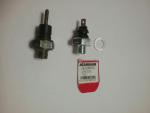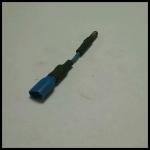-
Posts
630 -
Joined
-
Last visited
-
Days Won
15
Content Type
Profiles
Forums
Events
Gallery
Community Map
Posts posted by 68C
-
-
Tried to join up, it asks for a 'coupon code'?
-
I have never seen these K-Liners before, very interesting, I like the idea of not disturbing the old valve guide. Do they work OK with bronze valve guides?
-
Cosmetically challenged.
-
Slightly off topic, I confess to getting somewhat confused with the differences between Dot 4, 5 and 5.1 brake fluids.
As I understand it Dot 4 and Dot 5.1 are both glycol based and can be mixed whereas Dot 5 is a silicon fluid which cannot. Why on earth did they choose the Dot 5.1 classification, surely Dot 4.1 would have been better avoiding any confusion with the Dot 5 silicon fluid.
Like you Motowfo, I use silicon Dot 5 fluid, I merely mentioned the Norton IoM teams experience as an anecdote.
Perhaps I'll just have a few pints of Ringwood Best then pee in the reservoir and used an alcohol based fluid.
-
 1
1
-
-
That square seal is interesting in that it allows our disc brakes to work.
On applying the brake the square seal distorts allowing the slave piston to move far enough to press the pad onto the disc, when you release the brake the distorted square seal pulls the piston back a little to free the brake. The piston only slides through the square seal on initial assembly or to automatically take up pad wear.
The clutch slave cylinder travel is greater the piston does slide through the square seal and consequently the seal wears quicker. It does not need to be square seal, although usually is, as the spring inside the clutch slave cylinder does the returning action of the piston.
I remember talking to the Norton team at the '91 IOM TT, they said they did not like using silicon brake fluid on their race bikes as it was too slippery and compromised the returning action of the square seal which caused a slight dragging of the brakes. They suggested silicon fluid was only used to stop owners damaging their paintwork with spillage and to help when owners did not change the normal fluid regularly.
-
 3
3
-
-
Don't grizzlies eat moths, it's just I can see one standing up in the distance.
-
Good paint this, gives a great finish with a brush and dries quickly, I use it on trailer wheels etc.
The only problem is it needs their special thinners/brush cleaner although I have used lacquer thinner. Normal thinners or brush cleaner will not work.
Their data sheet lists the thinners:
http://www.hammerite.co.uk/files/2017/02/HM_GB_EN_BRUSH_CLEANER___THINNERS.pdf
-
I think the lower black parts look great.
-
Good find but at that price I would be looking at a Guzzi with another fifteen years of development.
-
Is this colonoscopy anything to do with re-calibrating one's butt dyno?
-
Replaced the oil pressure switch with a BMW320 car item.
My local auto parts shop supplied it as a Cambiare VE706070 which had a flat connector.
I cut the round stud off the old switch to make up a short adapter lead, pleased to see that revealed it was hollow which made soldering a wire into it easy. Crimped a flat female connecter to the other end, a little heat shrink and Bob's your auntie's live-in lover.
Oil pressure light now works OK, ignition on-engine not running = light on. Engine running = light out. Suprised it took about five seconds for the light to come back on when I stopped the engine, guess that is a good sign.
-
That 0.40mm makes all the difference as the lady sitting on my bike says.
-
Just to update this post in case anyone looks at it in the future.
Got the oil pressure switch out, measures up as 21mm. I tried a 13/16" standard UK plug socket, would not fit. In the end I used a Snap-On 7/8" plug socket from my aircraft toolbox which worked fine. I did notice the switch is very close to a raised part of the engine block so a cheaper socket may need grinding down a little.
To be fair to you Luhbo, I believe continental Europe uses 21mm as a plug wrench, the UK and probably others use 13/16". The switch was very tight, needed the socket with an extension bar and a 2 foot piece of pipe to shift it.
As it was so tight and as it has the round connector I assume this is the original switch
-
Thanks, I've even got a flexible one.
-
Hi all, bit of silly question, I need to replace my oil pressure switch but having trouble finding the spanner/socket size, access not good with tank and fairing on and did not want to strip bike down until I knew I had the right tool. If anyone has the switch to hand perhaps the could measure it for me. It seems to be around 22mm.
-
I had a go at it without much success.
I simply ran a long braided hose from the rear master cylinder to the left front caliper and a new single braided line from the front master cylinder to the right front caliper. I had to use a longer rear brake switch so I could mount the two pipes to the rear master cylinder.
Immediate problem was the front brake lever very hard to pull and the rear brake pedal had too much travel.
I then tried an old 12mm bore master cylinder for the front brake, this made things much better but did not match the clutch master cylinder. I then bolted another old master cylinder alongside the existing rear master cylinder and attached the new rear to front pipe to that. Had to mess about making a 'Y' shaped rod so both "rear" master cylinders were activated by the the rear brake pedal. This helped a lot. Then I found the rear brake pads wore out very quickly as they were getting used more. I did buy a pair of clutch and front brake radial master cylinders from Ebay but lost my nerve when I saw how badly made they looked.
As my prototype was not too pretty I took it all off so would not have any problems with the annual Ministry of Transport safety check.
Did not refit it.
In hindsight perhaps a rigid pipe would have been better from the rear master cylinder to the front of the frame then a short braided hose to the left caliper. I still think using two rear master cylinders with a 'y' rod to the rear brake lever is the way to go but have some way of adjusting the bias to allow good braking at the front without locking up the rear and so perhaps reduce rear pad wear. I have been looking for a 12mm front master cylinder that would match the clutch one. Some late 90's Italian bike with a single front disc?
-
BREXIT REFERENDUM
We have two cows, should we keep both of them? We have a referendum, neither the Keep nor the Sell parties present any reasoned arguements or hard facts. The referendum result is so close to a draw that we would not recognise the result from a third world country. The winning Sell party still do not give any firm facts or even discuss what will happen to the cows. The Keep party continue to feed both cows and obstruct all negotiations. The two cows continue to live together.
-
You can often 'control or feel' pinging, under load as you alter the throttle position the sound comes and goes, as the rpm increases you may be able to add a little throttle before the sound cones back. Either the mixture is too weak or the ignition timing is too advanced. I once had it on an old carb bike, turned out a spark plug thread was very sharp at the end and was probably glowing red hot, plug change and using a new crush washer cured it.
-
Sounds like you are going for a restoration. It is a shame as these bikes are only original once, just clean it and protect with WD40, dings in the tank are part of its history. If it did not have Nikasil barrels when made why change them? If you want a faster more reliable bike get someting else. Restoration should only be done on bikes that are in a very poor condition. Perhaps you could find a cheaper trashed Eldorado to restore.
-
I agree, leave it as original as possible, just make it legal and functioning. In another forty five years the next owner will be glad it was not 'restored'.
-
I've always found the fun had with a girl wearing high heels on my bike far outweighs any minor silencer damage.
-
 4
4
-
-
I have always admired Dr Blair of Queens University Belfast since his work on the 2 into 1 into 2 exhaust system back in the 70's on the Norton Commando.
-
 1
1
-
-
Good looking bellmouth. Have you had a chance to look at Dr Gordon Blair's work?
https://www.google.co.uk/url?sa=t&source=web&rct=j&url=http://www.profblairandassociates.com/pdfs/RET_Bellmouth_Sept.pdf&ved=0ahUKEwim6-LNtcTUAhVjIMAKHUeAAEYQFggoMAE&usg=AFQjCNHwmS5OuwPcpDnnWrcA9qmXLOVajg&sig2=bxIyY9BDLGhfMl2Bn2_KQg
The file was too big for me to attach. Perhaps moderator could do so.[moderator edit: I couldn't find a way to make that appear outside of the posted link, not even a representative copied image. Good link, though, and worth a look!, Best, docc]
-
 1
1
-
-
If these Odyssey batteries are so fussy why use them? My Rosso Corsa seems happy on a generic sealed battery, perhaps fashion has ruled here. You could have two standard batts for the price, one on the bike and one on float charge as a backup, or sitting unfilled as an emergency item.





ImgZeit Image hosting service
in Personal Ads
Posted
OK, got there in the end.
Simple once you know how,
Editted out my 'how to',
See further down the thread.